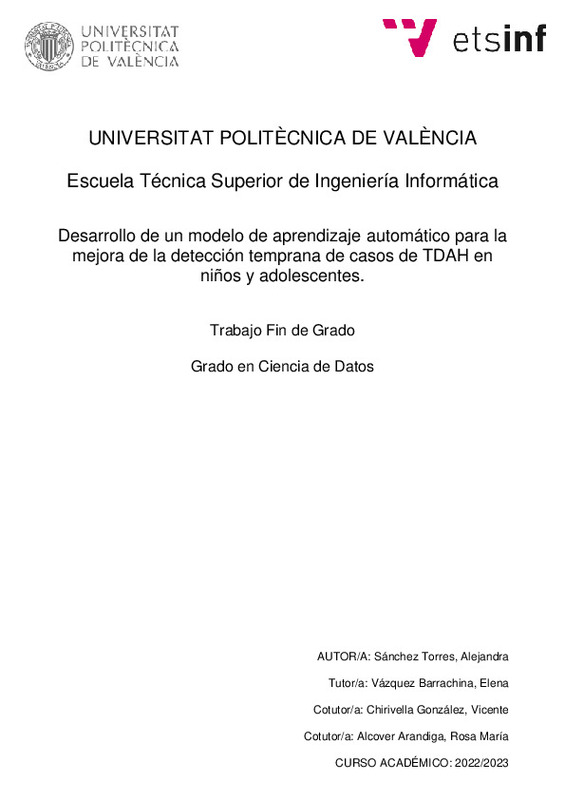|
Resumen:
|
[ES] El Trastorno por Déficit de Atención con Hiperactividad (TDAH) es un trastorno
neuropsiquiátrico que se caracteriza por la dificultad para mantener la atención, la hiperactividad
y la impulsividad. El TDAH es un ...[+]
[ES] El Trastorno por Déficit de Atención con Hiperactividad (TDAH) es un trastorno
neuropsiquiátrico que se caracteriza por la dificultad para mantener la atención, la hiperactividad
y la impulsividad. El TDAH es un trastorno del neurodesarrollo que afecta principalmente a niños
y adolescentes, pero también puede persistir en la edad adulta y es por ello por lo que se trata de
un tema de gran preocupación para la sociedad. En España, se estima que entre un 2 y un 5% de
la población infantil padece TDAH, afectando directamente al rendimiento académico, las
relaciones interpersonales y a la calidad de vida de los afectados. Por esta razón, es de vital
importancia abordar este trastorno desde diferentes enfoques para mejorar su detección y
tratamiento precoz. Actualmente, ya existen algunos estudios que están empezando a aplicar
técnicas de aprendizaje automático en este campo, no obstante, muchos de los modelos
desarrollados se basan intrínsecamente en modelos de diagnóstico estandarizados y datos
sesgados, que hacen que la calidad de predicción del modelo disminuya. Teniendo esto en mente,
el presente trabajo final de grado pretende desarrollar un modelo de aprendizaje automático, el
cuál será entrenado a través de unos datos recopilados directamente por personas que ya sufren la
enfermedad o tienen síntomas de ella. Por lo tanto, el objetivo final es el de conseguir una
temprana detección del TDAH tanto en niños como adolescentes, gracias al uso del modelo
desarrollado.
Como ya se ha comentado, se utilizarán datos, de niños y jóvenes en edad escolar, recopilados
a través de un cuestionario, el cual ha sido distribuido tanto a gran parte de las asociaciones de
TDAH en España como de forma personal. Los datos obtenidos a través de este cuestionario serán
analizados mediante técnicas estadísticas y de aprendizaje automático para identificar las
variables más relevantes para crear y entrenar el modelo.
Gracias a un diagnóstico más rápido, tanto los profesionales de la salud cómo de la educación
podrán, por un lado, brindar el apoyo y la atención necesarias para mejorar la calidad de vida y el
rendimiento académico de los afectados, y por otro, reducir significativamente sus respectivas
cargas de trabajo. En resumen, este trabajo final de grado tiene como objetivo contribuir al
desarrollo de herramientas efectivas y eficientes para la detección temprana del TDAH en niños
y adolescentes.
[-]
[EN] Attention Deficit Hyperactivity Disorder (ADHD) is a neuropsychiatric disorder with
symptoms such as difficulty in maintaining attention, hyperactivity, and impulsivity. It is a
neurodevelopmental disorder that ...[+]
[EN] Attention Deficit Hyperactivity Disorder (ADHD) is a neuropsychiatric disorder with
symptoms such as difficulty in maintaining attention, hyperactivity, and impulsivity. It is a
neurodevelopmental disorder that mainly affects children and adolescents, but can also persist
into adulthood, which is why it is a matter of great concern for society. In Spain, it is estimated
that between 2 and 5% of the child population suffers from ADHD, directly affecting academic
performance, interpersonal relationships, and the quality of life of those affected. For this reason,
it is vitally important to address this disorder from different approaches to improve its early
detection and treatment. Currently, there are already some studies that are starting to apply
machine learning techniques in this field, however, many of the models developed are based on
standardised diagnostic models and biased data, which makes the predictive quality of the model
decrease. Taking all of this into consideration, this final thesis aims to develop a machine learning
model, which will be trained on data collected directly from people who already suffer from the
disease or have symptoms of the disease. Therefore, the main goal is to achieve an early detection
of ADHD in both children and adolescents, thanks to the use of the developed model.
As already mentioned, data will be used, from school-aged children and young people,
collected through a questionnaire, which has been distributed both to most of the ADHD
associations in Spain and personally. The data obtained through this questionnaire will be
analysed using statistical and machine learning techniques to identify the most relevant variables
to create and train the model.
Thanks to a quicker diagnosis, both health and education professionals will be able, on the one
hand, to provide the necessary support and care to improve the quality of life and academic
performance of those affected, and on the other hand, to significantly reduce their respective
workloads. In summary, this final thesis aims to contribute to the development of effective and
efficient tools for the early detection of ADHD in children and adolescents.
[-]
|







